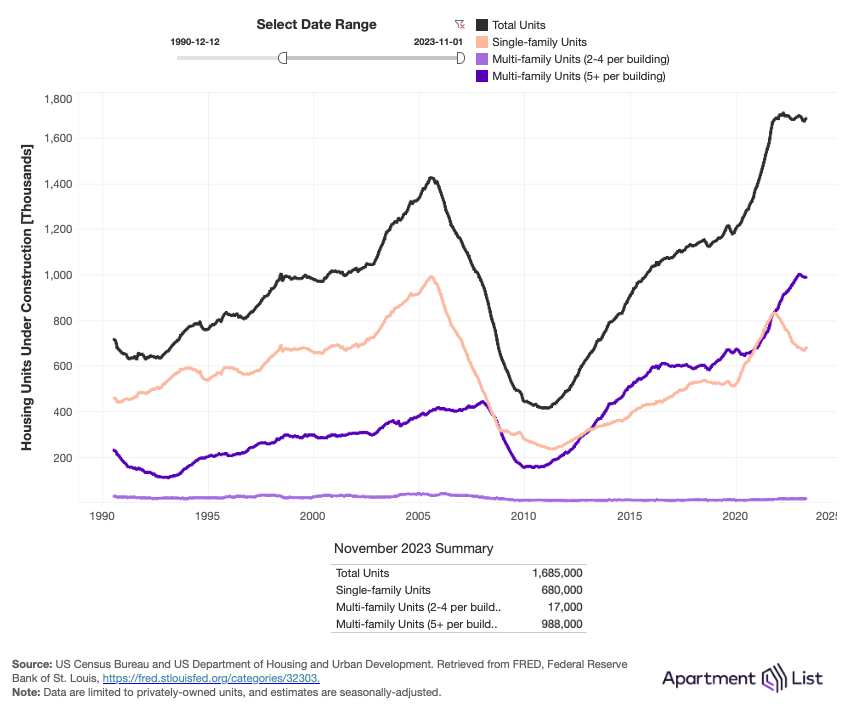As of November 2023, it was estimated that there were 988,000 homes under construction in multi-family buildings containing 5 or more units. This is in comparison to 680,000 single-family homes, according to US Census data. (Looking at the below graph, it’s also interesting to see how the supply of single-family homes dropped off after the global financial crisis and multi-family apartments took off.)

All of this means that in 2024, the US is on track to complete more apartments than it has in many many decades. In fact, exactly similar to what we experienced here in Toronto, if you want to find a comparable multi-family supply number, you need to go as far back as the 1970s (see below). Of course, the US had fewer people back then, and so on a per capita basis, it was building more housing.

Still, all of this new supply is having an impact. Apartment List recently published its national rent report, over here. And overall, it found that:
Rent increases are currently being moderated by a robust construction pipeline expected to deliver a decades-high number of new apartment units in 2024.
More specifically, they found that the cities with the most supply are now seeing the largest rent declines:
Many of the steepest year-over-year declines remain concentrated in Sun Belt cities that are rapidly expanding their multifamily inventory, such as Austin (-7.4 percent year-over-year), Raleigh (-4.4 percent), and Orlando (-3.9 percent).
If you’re an apartment developer, this is not what you want to see. It means that increased competition is creating downward pressure on rents and that vacancy rates are probably rising. But if you’re someone looking to rent an apartment, this is exactly what you want to see. You want more affordable housing. And so, as a consequence, you want more homes to be built. Because when supply outstrips demand, this is what you get.
Charts: Apartment List

The American population was 200-220m from 1970-1979, so the population was a bit over half of today’s 2024 341m when the peak of the last comparable boom hit: https://www.macrotrends.net/global-metrics/countries/USA/united-states/population-growth-rate
Also, at that time the American population growth rate was about double what it is today, meaning women – but more likely, couples because women didn’t work as much back then – had more children.
So, the challenge today is not only to build more housing, but to build for more single parents, or just plain singles with no kids at all, even in mid-life.
Since the most expensive part of any unit is the kitchen and the bathroom and since every unit needs at least one of those, even if the kitchen is nowadays part of a dining area or even a “Great Room” including a living area, it’s not possible to simply build units with fewer rooms for single people in order to save money. Developers are constrained from building tiny apartment much below 300sq in most American cities because of zoning laws and regulations about light and air access, etc., but even if they could, renters demand more space in all but the most extreme circumstances. Here in NYC, Single Room Occupancy (SROs) with shared bathrooms and kitchens have just been re-legalized with, it is hoped, better maintenance and hygiene. It has a stigma of being for low-income people, however, but with way more legal rights than back in the 1970s: https://reyabogado.com/us/what-are-the-rights-of-sro-tenants-in-nyc/. It remains to be seen how well this SRO 2.0 works out, but it will certainly never eclipse the number of studio apartments. Dense cities like NYC remain impossible for many, if not most, families with 1-2 or more children (there’s also an expectation that every child should have his or her room), without some kind of government subsidy.
We have a long way to go to catch up to the options America had in the 1970s.
LikeLiked by 1 person